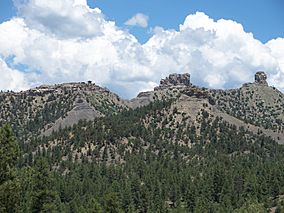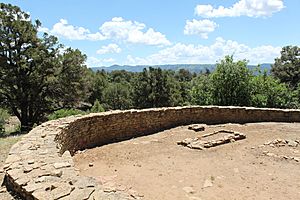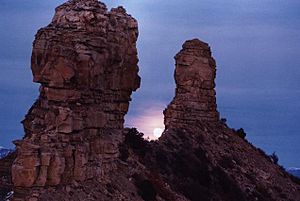Chimney Rock National Monument facts for kids
Quick facts for kids Chimney Rock National Monument |
|
|---|---|

Chimney Rock is on the right, Companion Rock on the left
|
|
| Location | Archuleta County, Colorado, USA |
| Nearest city | Chimney Rock, Colorado |
| Area | 4,726 acres (19.13 km2) |
| Authorized | September 21, 2012 |
| Governing body | U.S. Forest Service |
| Website | Chimney Rock National Monument |
| Designated: | August 25, 1970 |
| Reference #: | 70000153 |
| Official name: Chimney Rock Archaeological Area | |
| Reference #: | 5AA.985 |
Chimney Rock National Monument is a special place in southwestern Colorado. It covers about 4,726 acres (19 square kilometers) within the San Juan National Forest. This monument protects an important archaeological site, which is a place where people lived long ago.
The monument is located in Archuleta County, Colorado, between the towns of Durango and Pagosa Springs. It is carefully managed to protect its ancient history, offer tours, and teach people about the past. The Chimney Rock Archaeological Site has been recognized as a historic place since 1970. In 2012, U.S. President Barack Obama officially made it a National Monument. He used a law called the Antiquities Act to do this.
Contents
What is Chimney Rock Like?
Chimney Rock National Monument is a large area of land. It is surrounded by the Southern Ute Indian Reservation. The main archaeological area, which is listed as a historic place, covers about 960 acres.
The rock formation called Chimney Rock is very tall, about 315 feet (96 meters) high. Right next to it is another rock called Companion Rock. This rock is a favorite nesting spot for peregrine falcons, which are very fast birds.
The ancient settlements found here are mostly on a ridge. This ridge ends at Chimney Rock. The ridge itself is made mostly of sandstone rock.
Who Lived at Chimney Rock?
About 1,000 years ago, a group of people called the Ancestral Puebloans lived at Chimney Rock. This community was located between Durango and Pagosa Springs. It had about 200 rooms, which were used for living, working, and special ceremonies.
The site is part of the San Juan National Forest. From May 15 to September 30, you can visit the center. Guided walking tours are offered every day during this time.
Around 925 AD to 1125 AD, about 2,000 ancient Pueblo people lived here. Their settlement included a large building called the Great House Pueblo. This building had round ceremonial rooms called kivas. It also had 36 rooms on the ground floor.
Archaeologists found a grizzly bear jaw in one of the rooms. This suggests that the people respected bears. Some stories from the modern Chaco culture say that their Bear clan started in the Chimney Rock area.
The Chaco Culture and the Moon
The Chaco culture, who lived at Chimney Rock, had a special way of life. They had leaders, possibly priests, who guided the community. The Great House Pueblo was built high on the ridge, near Chimney Rock and Companion Rock. This building played a very important role in their ceremonies.
This area is special because of the moon. Every 18.6 years, the moon appears to stop between the two rocks. This event is called a lunar standstill. It can be seen for about 16 months.
Evidence shows that the Great House Pueblo was first built in 1076 AD. This was during a lunar standstill. It was finished and made bigger in 1093 AD, during another standstill. The building has 36 rooms and two kivas.
Archaeologists believe the Great House Pueblo was mostly for ceremonies. Only one or two families might have lived there all the time. During important ceremonies, it may have acted like a hotel. Important visitors came from places like Chaco Canyon, which is 90 miles away in New Mexico.
Building the Great House Pueblo
The materials to build the Great House Pueblo were brought from downhill. Workers carried them by hand up the ridge. Five small houses, called pithouses (Rooms A through E), likely housed these workers.
Early archaeologists dug up Rooms A and B in 1921–1922. However, they did not know how to protect the walls well. They also used wood from the ruins for their campfires. Because of this, not much is known about these specific ruins today. The pottery they found was saved. It is now stored in a museum in Durango.
Halfway between the workers' houses and the Great House Pueblo was another ruin. Archaeologists called it the "Guardhouse." It stretched across the ridge. One family lived there. It was probably not for defense against attackers. Instead, it likely controlled who could enter the Great House Pueblo. It would let important people pass through. This ruin became very unstable after it was dug up. The Forest Service later removed it to keep visitors safe.
The path to the Great House Pueblo starts near a group of three pithouses. These houses had other workrooms nearby. A large family, with many generations, would have lived here. Digging in the workrooms showed different areas. There were grinding stones for corn. There was also a place where men would make arrowheads and tools.
The last two sites that were dug up are a single pithouse and the Great Kiva. The Great Kiva is similar to other kivas found in the Southwest. It has a central fire pit, a stone to block drafts, and a ventilation shaft.
However, it also has unique features. Instead of a bench around the edge for storing special items, it has several pits in the ground. These pits were probably for storage. When it was dug up, archaeologists found very little wood or roof materials. They thought it might have been open to the sky. Another idea is that it was never finished. It was built in 1084, but the people left before it was done. Or, perhaps the builders thought it had bad spirits and decided not to finish it.
Why Did They Leave?
The people of Chimney Rock left the site in 1125. They burned the buildings when they left. Their descendants today consider the site sacred. They believe the spirits of their ancestors are there. Because of this, they have asked the Forest Service not to dig up any more of the site.
Since the 1960s, researchers like Frank Eddy from the University of Colorado have studied the site. Research is still ongoing. So far, eight villages or settlements have been found in the area. Most of these have not been dug up since Eddy's work in the early 1970s.
In 2012, President Barack Obama used the Antiquities Act to make the archaeological site a national monument. This helps protect it for future generations.
Today, you can take guided or self-guided tours. They start at a small visitor center. The guided tour has two parts. The first is a paved path about a quarter-mile long. It goes through parts of the site that haven't been dug up, and past the Great Kiva and single pithouse. The second part is a more difficult dirt and rock path, about a third of a mile long. It goes past the pithouse complex, Rooms A-E, the Guardhouse, and the Great House Pueblo. The tour takes about 2.5 hours. It gives lots of information about the people who lived there.
Since Chimney Rock became a National Monument, volunteers and staff have asked for money to build a small museum. This museum would display information and items found during digs. Right now, all the artifacts are stored in boxes in museums across the Four Corners Region.
Wildlife at Chimney Rock
In the mid-1970s, Companion Rock was home to one of only seven pairs of peregrine falcons in the Rocky Mountains. A scientist named Marcy Cottrell Houle studied these falcons. She wrote a book about her experiences called Wings for My Flight: The Peregrine Falcons of Chimney Rock.
Peregrine falcons still come back to Companion Rock to nest every year.
Learning Opportunities
Chimney Rock National Monument offers unique ways to learn. For example, a group of 26 people in Ohio took a "virtual" tour. They rode stationary bikes while learning about the monument's history.






